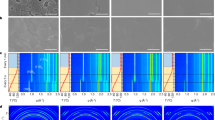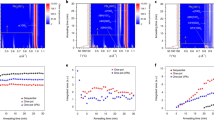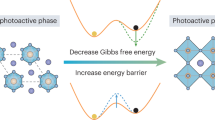Abstract
The black phase of formamidinium lead iodide (FAPbI3) perovskite shows huge promise as an efficient photovoltaic, but it is not favoured energetically at room temperature, meaning that the undesirable yellow phases are always present alongside it during crystallization1,2,3,4. This problem has made it difficult to formulate the fast crystallization process of perovskite and develop guidelines governing the formation of black-phase FAPbI3 (refs. 5,6). Here we use in situ monitoring of the perovskite crystallization process to report an oriented nucleation mechanism that can help to avoid the presence of undesirable phases and improve the performance of photovoltaic devices in different film-processing scenarios. The resulting device has a demonstrated power-conversion efficiency of 25.4% (certified 25.0%) and the module, which has an area of 27.83 cm2, has achieved an impressive certified aperture efficiency of 21.4%.
This is a preview of subscription content, access via your institution
Access options
Access Nature and 54 other Nature Portfolio journals
Get Nature+, our best-value online-access subscription
$29.99 / 30 days
cancel any time
Subscribe to this journal
Receive 51 print issues and online access
$199.00 per year
only $3.90 per issue
Buy this article
- Purchase on Springer Link
- Instant access to full article PDF
Prices may be subject to local taxes which are calculated during checkout




Similar content being viewed by others
Data availability
The data that support the findings of this study are available from the corresponding authors upon reasonable request.
References
Doherty, T. A. S. et al. Stabilized tilted-octahedra halide perovskites inhibit local formation of performance-limiting phases. Science 374, 1598–1605 (2021).
Lee, J.-W., Seol, D.-J., Cho, A.-N. & Park, N.-G. High-efficiency perovskite solar cells based on the black polymorph of HC(NH2)2PbI3. Adv. Mater. 26, 4991–4998 (2014).
Turren-Cruz, S.-H., Hagfeldt, A. & Saliba, M. Methylammonium-free, high-performance, and stable perovskite solar cells on a planar architecture. Science 362, 449–453 (2018).
Xue, J. et al. Surface ligand management for stable FAPbI3 perovskite quantum dot solar cells. Joule 2, 1866–1878 (2018).
Yang, M. et al. Facile fabrication of large-grain CH3NH3PbI3-xBrx films for high-efficiency solar cells via CH3NH3Br-selective Ostwald ripening. Nat. Commun. 7, 12305 (2016).
Sánchez, S., Pfeifer, L., Vlachopoulos, N. & Hagfeldt, A. Rapid hybrid perovskite film crystallization from solution. Chem. Soc. Rev. 50, 7108–7131 (2021).
Eperon, G. E. et al. Formamidinium lead trihalide: a broadly tunable perovskite for efficient planar heterojunction solar cells. Energy Environ. Sci. 7, 982–988 (2014).
Jiang, Q. et al. Surface passivation of perovskite film for efficient solar cells. Nat. Photon. 13, 460–466 (2019).
Qiu, Z. et al. Recent advances in improving phase stability of perovskite solar cells. Small Methods 4, 1900877 (2020).
Zhang, Y. et al. Propylammonium chloride additive for efficient and stable FAPbI3 perovskite solar cells. Adv. Energy Mater. 11, 2102538 (2021).
Bu, T. et al. Lead halide-templated crystallization of methylamine-free perovskite for efficient photovoltaic modules. Science 372, 1327–1332 (2021).
Hui, W. et al. Stabilizing black-phase formamidinium perovskite formation at room temperature and high humidity. Science 371, 1359–1364 (2021).
Nan, Z.-A. et al. Revealing phase evolution mechanism for stabilizing formamidinium-based lead halide perovskites by a key intermediate phase. Chem 7, 2513–2526 (2021).
Qin, M., Chan, P. F. & Lu, X. A systematic review of metal halide perovskite crystallization and film formation mechanism unveiled by in situ GIWAXS. Adv. Mater. 33, 2105290 (2021).
Li, Z. et al. Scalable fabrication of perovskite solar cells.Nat. Rev. Mater. 3, 18017 (2018).
Xie, Y.-M., Xue, Q. & Yip, H.-L. Metal-halide perovskite crystallization kinetics: a review of experimental and theoretical studies. Adv. Energy Mater. 11, 2100784 (2021).
Lee, J.-W., Lee, D.-K., Jeong, D.-N. & Park, N.-G. Control of crystal growth toward scalable fabrication of perovskite solar cells. Adv. Funct. Mater. 29, 1807047 (2019).
Dubey, A. et al. A strategic review on processing routes towards highly efficient perovskite solar cells. J. Mater. Chem. A 6, 2406–2431 (2018).
Engler, O., Vatne, H. E. & Nes, E. The roles of oriented nucleation and oriented growth on recrystallization textures in commercial purity aluminium. Mater. Sci. Eng. A 205, 187–198 (1996).
Tan, H. et al. Efficient and stable solution-processed planar perovskite solar cells via contact passivation. Science 355, 722–726 (2017).
Lin, R. et al. Monolithic all-perovskite tandem solar cells with 24.8% efficiency exploiting comproportionation to suppress Sn(II) oxidation in precursor ink. Nat. Energy 4, 864–873 (2019).
Lee, J.-W. et al. Solid-phase hetero epitaxial growth of α-phase formamidinium perovskite. Nat. Commun. 11, 5514 (2020).
Wang, F. et al. Phenylalkylamine passivation of organolead halide perovskites enabling high-efficiency and air-stable photovoltaic cells. Adv. Mater. 28, 9986–9992 (2016).
Ilavsky, J. Nika: software for two-dimensional data reduction. J. Appl. Crystallogr.45, 324–328 (2012).
Ilavsky, J. & Jemian, P. R. Irena: tool suite for modeling and analysis of small-angle scattering. J. Appl. Crystallogr. 42, 347–353 (2009).
Acknowledgements
We thank X. Miao, L. Liu, T. Zhou from Instrumentation and Service Center for Physical Sciences, and X. Lu and Z. Chen from Instrumentation Service Center for Molecular Sciences, Westlake University for help with characterizations and S. Yuan from Zhejiang University for discussions about the crystallization of perovskites. J.Xue. and R.W. acknowledge a grant from the Natural Science Foundation of Zhejiang Province of China (LD22E020002). J.Xue. acknowledges grants from the National Natural Science Foundation of China (62274146), the Shanxi-Zheda Institute of Advanced Materials and Chemical Engineering (2021SZ-FR006) and the Foundation for Innovative Research Groups of the National Natural Science Foundation of China (61721005). R.W. acknowledges funding from Westlake University. M.K.N. and P.J.D. thank the Valais Energy Demonstrators fund. This work was also supported by the National Natural Science Foundation of China (62204209). We used the resources of the Advanced Light Source and the US Department of Energy Office of Science User Facility (contract DE-AC02-05CH11231), beamline 12.3.2 and the in situ spin coater. Work at the Molecular Foundry was supported by the Office of Science and Office of Basic Energy Sciences of the US Department of Energy (contract DE-AC02-05CH11231) T.K. thanks the German Research Foundation (DFG) for funding (KO6414). Computing resources used in this work were provided by the National Center for High Performance Computing of Turkey (UHeM).
Author information
Authors and Affiliations
Contributions
J.Xue., R.W. and P.S. conceived the idea. P.S. did the two-step fabrication of perovskite films and devices, and performed the data analysis under the supervision of J.Xue. and R.W. Y.D. and B.D. did the one-step fabrication of the small-area perovskite devices and fabricated the modules under the supervision of M.K.N. Q.X. and S.T. did the in situ characterizations under the supervision of Y.Y. and C.M.S.-F. C.M.S.-F., J.L.S. and T.K. designed the in situ photoluminescence, the in situ multimodal diffraction monitoring system and facilitated the in situ measurements. I.Y. and C.Y. did the theoretical calculations. W.F., J.Xu., Y.T., D.G., X.Z., K.Z. and L.Y. assisted with the characterizations and device fabrication. P.J.D. and D.Y. provided discussions. J.Xue. wrote the manuscript. All the authors discussed the results and commented on the manuscript.
Corresponding authors
Ethics declarations
Competing interests
The authors declare no competing interests.
Peer review
Peer review information
Nature thanks the anonymous reviewers for their contribution to the peer review of this work.
Additional information
Publisher’s note Springer Nature remains neutral with regard to jurisdictional claims in published maps and institutional affiliations.
Extended data figures and tables
Extended Data Fig. 1 FTIR measurements for investigating the interaction between PAd and Pb-I framework.
FTIR spectra of PAd, PbI2 and PAd mixed with PbI2.
Extended Data Fig. 2 DFT slabs of FA-based perovskite lattice with different surface termination.
The slab of a, bare FA-based perovskite and the ones terminated with b, PRd, c, BAd, d, PAd, and the surface energies of the (100) planes.
Extended Data Fig. 3 In-situ GIXRD patterns of perovskite films.
In-situ GIXRD patterns of a, the control perovskite film and the ones fabricated with b, PRd, c, BAd, d, PAd.
Extended Data Fig. 4 Evolutions of the azimuth angles during the nucleation stage of perovskite films.
Evolution of the azimuth angle during the nucleation of a, the control perovskite film and the films fabricated with b, PRd, c, BAd and d, PAd.
Extended Data Fig. 5 In-situ GIXRD monitoring of the initial nucleation stage of perovskite films.
In-situ GIXRD monitoring of the initial nucleation stage of perovskite films fabricated a, with and b, without PAd. The control perovskite nuclei contained a diffraction peak at around 14°, whereas the one with PAd showed a diffraction peak at around 14.4°, indicating compressive strain within the lattice of the perovskite nuclei.
Extended Data Fig. 6 Evolution of the PL spectra during the perovskite nucleation stage.
Evolution of the PL spectra during the nucleation stage of a, the control perovskite film and the ones with b, PRd, c, BAd and d, PAd.
Extended Data Fig. 7 Optical properties of perovskite films.
a, TRPL plots of the perovskite film with PAd and the control. The PL lifetime was fitted to be 4.89 μs and 0.5 μs for the perovskite film with PAd and the control, respectively. b, PL spectra of the perovskite film with PAd and the control. The above-mentioned perovskite films were deposited by two-step method on glass substrates for measurements.
Extended Data Fig. 8 Photovoltaic parameters of perovskite devices made by two-step method.
Box plots showing the distribution of the a, PCE, b, FF, c, Voc, and d, Jsc for the control and the PAd devices made by two-step method. Centre line, median; box limits, 25th and 75th percentiles; curve, normal distribution curve; whiskers, outliers.
Extended Data Fig. 9 Photovoltaic parameters of perovskite devices made by one-step method.
Box plots showing the distribution of the a, FF, b, Voc, and c, Jsc for the control and PAd devices made by one-step method. Centre line, median; box limits, 25th and 75th percentiles; curve, normal distribution curve; whiskers, outliers.
Extended Data Fig. 10 Photovoltaic parameters of perovskite modules.
Box plots showing the distribution of the a, PCE, b, FF, c, Voc, d, Isc for the control and the PAd-based perovskite modules with an aperture area of 30.86 cm2. Centre line, median; box limits, 25th and 75th percentiles; curve, normal distribution curve; whiskers, outliers. In this case, the width of P2 lines and P3 lines was 200 μm and 100 μm respectively and the geometric fill factor (GFF) is around 0.90.
Supplementary information
Supplementary Information
This file contains Supplementary Notes 1–4, Supplementary Figs. 1–25, Supplementary Tables 1–3 and references.
Rights and permissions
Springer Nature or its licensor (e.g. a society or other partner) holds exclusive rights to this article under a publishing agreement with the author(s) or other rightsholder(s); author self-archiving of the accepted manuscript version of this article is solely governed by the terms of such publishing agreement and applicable law.
About this article
Cite this article
Shi, P., Ding, Y., Ding, B. et al. Oriented nucleation in formamidinium perovskite for photovoltaics. Nature 620, 323–327 (2023). https://doi.org/10.1038/s41586-023-06208-z
Received:
Accepted:
Published:
Issue Date:
DOI: https://doi.org/10.1038/s41586-023-06208-z
This article is cited by
-
Vapour-deposited perovskite light-emitting diodes
Nature Reviews Materials (2024)
-
Dopant-additive synergism enhances perovskite solar modules
Nature (2024)
Comments
By submitting a comment you agree to abide by our Terms and Community Guidelines. If you find something abusive or that does not comply with our terms or guidelines please flag it as inappropriate.



